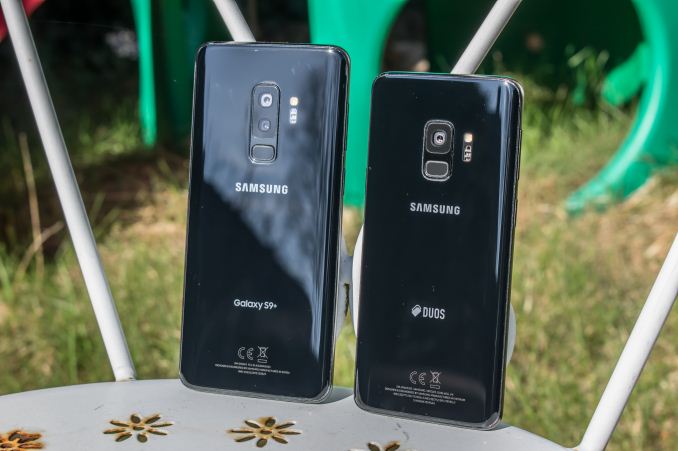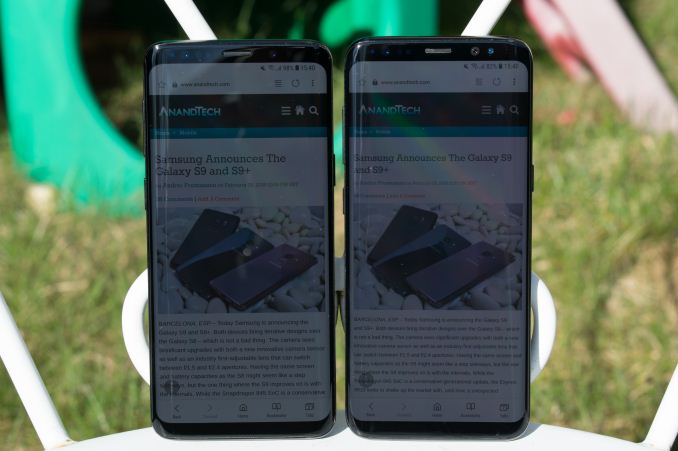The Samsung Galaxy S9 and S9+ Review: Exynos and Snapdragon at 960fps
by Andrei Frumusanu on March 26, 2018 10:00 AM ESTConclusion & End Remarks
The conclusion for the Galaxy S9 is always the toughest part to write as it’s where we have to reconcile all the pros and cons of the device and making a verdict on its value as a product to customers.
In terms of design, the S9 iterates on the S8 and I think that’s definitely a positive until Samsung somehow produces a better design overhaul. The changes we find here aren’t exactly ground-breaking and most people will get used to them very fast. The fingerprint scanner location is among the biggest ergonomics changes and while for me personally it didn’t do much, there’s plenty of people who find it an improvement.
The speaker sound quality of the Galaxy S9 is a massive improvement and this is now by far the best sounding smartphone device. The stereo speakers as well as the audio processing tuning along with the improved main speaker design all just provide a much better experience. I may not have covered this in the introduction, but Samsung’s choice to retain the 3.5mm jack is absolutely the right thing to do. I’ve got very strong feelings about companies’ rationales behind removing the headphone jack and find their reasoning either misguided or outright misleading, and just very anti-consumer choice. Here’s to hoping that Samsung sticks with it in the future, and as absurd as this is that I have to praise them for it, I have to do it to ensure that companies listen.
The screen of the Galaxy S9 holds very little surprises as it has only marginal improvements over the S8. It’s still among one of the best screens on smartphones, and honestly there’s not much more to say.
The camera of the Galaxy S9 for me had some high points and some low points. The high points are that the variable aperture of the S9 has real benefits and direct advantages in picture quality in day-light shots. The S9’s reduced usage of sharpening provided the cleanest pictures among all smartphones and thanks to its improved sensor its effective spatial resolution is actually higher than some higher resolution camera devices. The low-light shots also come with a quality improvement over the S8 – although it will depend on the lightning and scene to notice them at their full effect. Right now the S9 has the best low-light camera.
While the hardware of the S9’s camera definitely deserves praise, the software has notable issues in daylight shots. The Galaxy S9 has a very bad tendency to overexpose and compress the image’s dynamic range. In Pro mode these issues largely go away, but for the Galaxy S9 to offer a better point-and-shoot experience than the S8 or the new iPhones, Samsung needs to rework its camera calibration in Auto mode as right now it can be the odd one out in terms of results.
Finally, the biggest story for the Galaxy S9 is its big contrast in terms of SoC hardware. Ever since we first heard about the Exynos 9810 we had very large expectations and we knew there would be some tangible differences between Exynos and Snapdragon variants. The expectations couldn’t be more shattered than the results we got. While the Snapdragon 845 variant of the Galaxy S9 performed largely as advertised and as we had been told to expect by Qualcomm, the Exynos 9810 failed to live up to its hype in real-world scenarios. Effectively, the Exynos 9810 variant and as evidenced by all the data we collected, is the slower variant of the two. The root cause here has been identified as the extremely conservative scheduler and DVFS mechanisms which essentially nullify any advantage the new M3 cores have in synthetic benchmarks.
In 3D benchmarks, the Exynos 9810 posted very healthy efficiency improvements and even sometimes managed to catch up to last year’s Adreno 540 – something I hadn’t expected. Qualcomm’s new Adreno 630 raises the bar in terms of peak performance, however the promises of increased efficiency have not materialised in the commercial hardware as the performance boost comes at a cost of increased power. Effectively, when looking at sustained workloads, the Snapdragon 845 isn’t any faster than the Snapdragon 835 in its GPU department. Fortunately for Qualcomm, they’re still in the lead and this is not a deal-breaker for the Galaxy S9.
While the performance advantage of the Snapdragon 845 variant over the Exynos 9810 variant is something we could live with, the battery life results of the Exynos is definitely a deal-breaker. I’m not sure of the root cause here and whether it’s something that can be fixed by software, but showcasing such a battery runtime regression over its predecessor is universally something that we can all agree on as not acceptable for a flagship device. Based on our testing, it’s especially in heavy use-cases where this will most evident. The Snapdragon 845 variant performed as expected in the battery life tests.
Finally the recommendation of the Galaxy S9 will be based on which market you are in and which variant you’ll be able to purchase. The Snapdragon 845 variant in the US, China and Japan is a healthy upgrade over its predecessors and I don’t really have much to say against it as a phone, besides the camera exposure issues. Here Samsung iterated and perfected over the S8, and whether the S9 is worth to you as an upgrade is something you’ll need to decide based on its individual parts, because as a package, the Snapdragon S9s don’t disappoint.
For readers in markets with the Exynos variant I need to take a slightly different tone. Make no mistake as I say that the Exynos S9 is by far not a bad phone. If you come from older generation devices you will see significant upgrades, but as a flagship coming at a price premium we expect a no-compromise device, and here is where the Exynos S9 doesn’t tick all boxes. The battery life regression that we measured is the single most concerning aspect of the device. Here buyers will need to consider the device with caution and well-thought out consideration and should maybe apply a wait & see approach over the coming months – for one to see if Samsung resolves the issues via software, and secondly, to await the release of competitor’s new product lines for possible better alternatives.












190 Comments
View All Comments
Javert89 - Saturday, March 31, 2018 - link
I think there are two feasible ways to improve battery life: downclock the chip to SD845 or even SD835 peak performance level and "free up" the current scheduler from conservativeness; or implement a much more advanced scheduler to improve both performance over short bursts and battery life over long term. I think the new DynamIQ system could make more advanced scheduling possible; I have in mind the old Krait architecture where each core had a different frequency; but in Exynos 9810 each core of the big cluster has apparently the same frequency, according to CPU-Z on Youtube videos ..... In the short term, a downclock is the most feasible solution; in the long term, assuming they will insist with 6-wide decoders big cores, they will need to implement the more advanced schedulerMonty1401 - Tuesday, April 3, 2018 - link
Thanks for the response - I'm loathed to root/ flash a kernel to a brand new device just for the sake of slowing it down and I doubt that Samsung will address the issue before my deadline for returning the handset. It's a very big £850 gamble to hold onto it & hope they fix it - will probably return the device and see if they solve the issue (they must surely come up with a fix before they release the Note with the same SOC!?) or be forced to accept a worse screen on the oneplus/ pixel handsets. :(yhselp - Friday, March 30, 2018 - link
A bit late to the party, sorry, but I'd like to ask a question: while it's obviously better to have a 3.5 mm headphone jack, is it not true that getting rid of the jack itself and accompanying electronics, DAC, etc. frees up space and saves weight? Apple seems to have benefited in terms of weight going from the iPhone 6s to the 7 because of the removal of the headphone jack.Oyeve - Monday, April 2, 2018 - link
I highly doubt the jack and accompanying electronics would make a noticeable difference in weight.ZeDestructor - Monday, April 2, 2018 - link
Looking at other phones of similar volume but without a 3.5mm jack (like the Huawei P20 Pro and Razer phone), it looks like you get more battery for the loss of your 3.5mm jack (to the tune of ~500mAh)bogda - Tuesday, April 3, 2018 - link
Removing headphone jack from iPhone has nothing to do with increase a battery size in iPhone 7. Check any teardown of iPhone 7 on internet and it will be crystal clear.This guy added headphone jack himself to iPhone 7: https://www.youtube.com/watch?v=utfbE3_uAMA
Check Jerry's thoughts on this matter: https://www.youtube.com/watch?v=PmTSN4zWeQ0
bogda - Monday, April 2, 2018 - link
I love your comment about headphone jack, and specially the stress you put on it in closing thoughts.I can understand reasoning why Apple erased their headphone jack. They are going to sell millions of their trendy wireless Earpods. Their customers obviously do not care.
But even smallest Android manufacturers are kicking out headphone jack in their top models. It is pure ignorance and bad reasoning in my opinion. Hardly any of them will sell significant number of "their" wireless headphones and will lose some customers because of that.
If I buy flagship device I want more features, not fewer. All those "trendy" Android phone makers have definitely lost me as a customer.
madnav - Tuesday, April 3, 2018 - link
As a user of both S8 and S8+ running Exynos 8895, I can tell from my observation that both devices performed slightly differently despite of being very similar. One seemed tuned for battery endurance while the other seems tuned for swift performance.It is my humble request to update the review with differences (or lack of) if AnandTech manages to test Exynos S9+ as well.
NotcyNews - Wednesday, April 4, 2018 - link
Interesting news.Samsung remain my favorite phone.Anirudhsarma - Thursday, April 5, 2018 - link
What happens if use the settings option to lower the clock speed of the processor does this help battery life